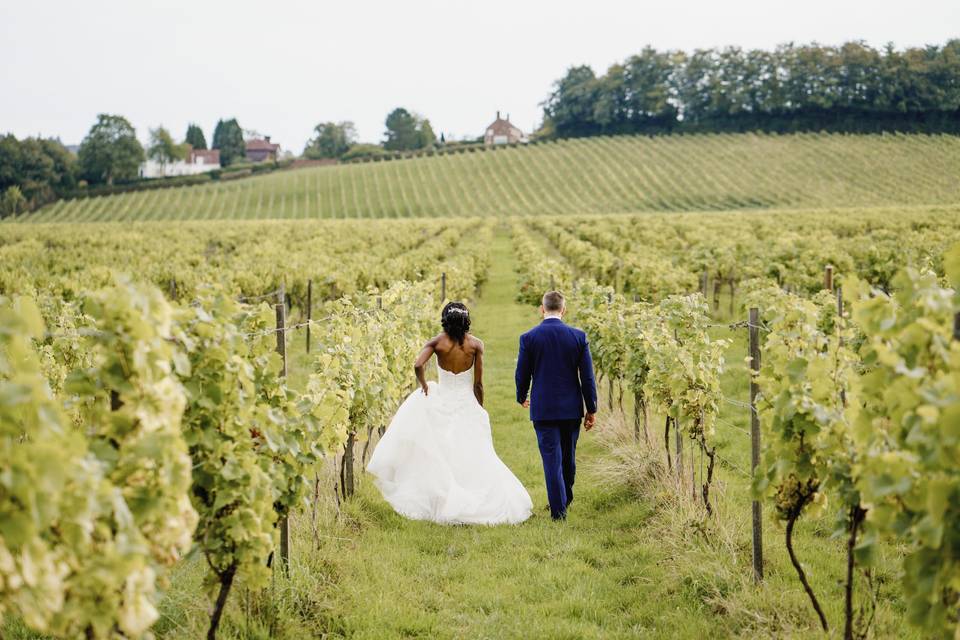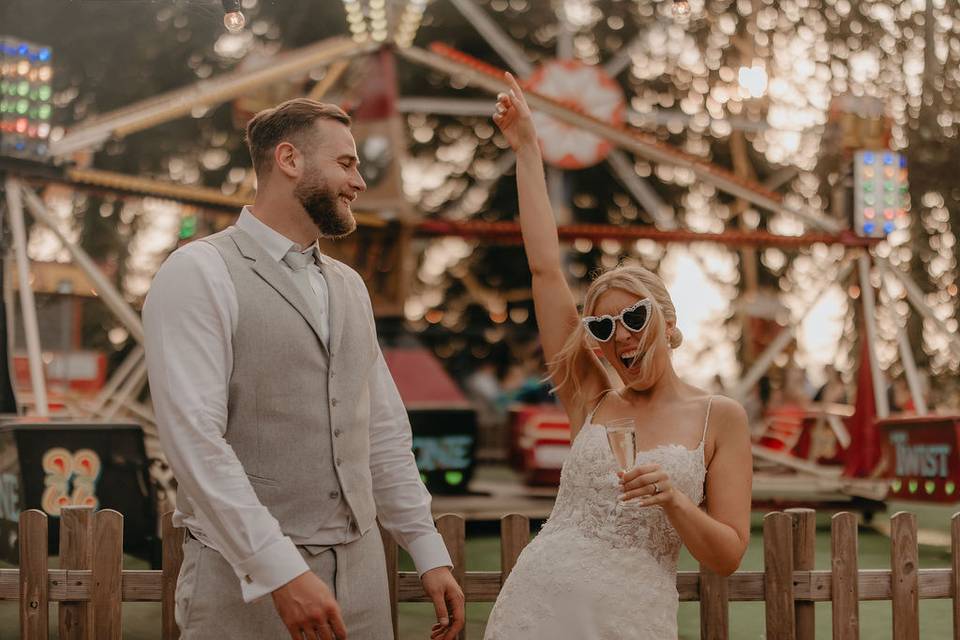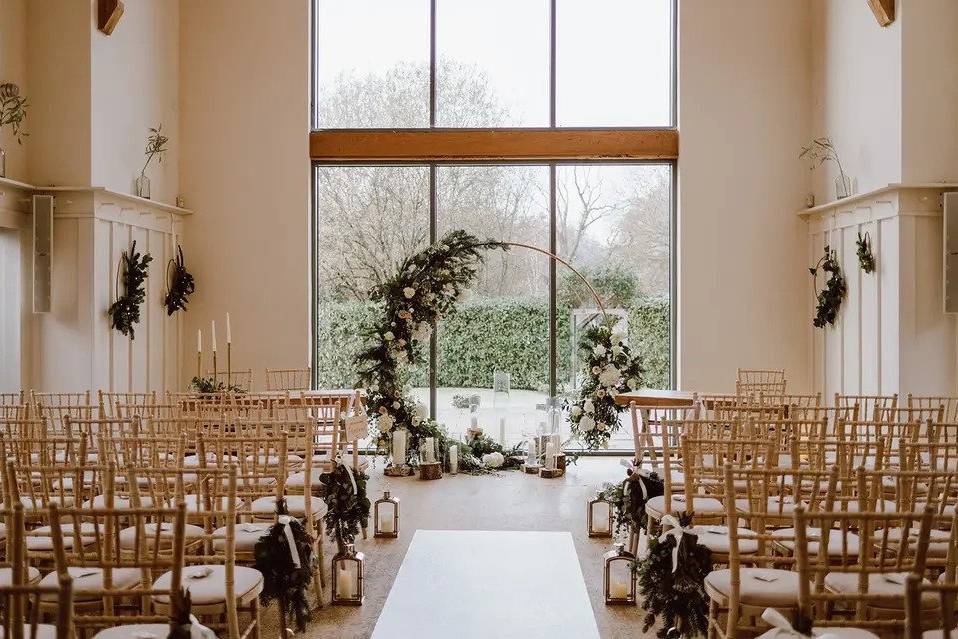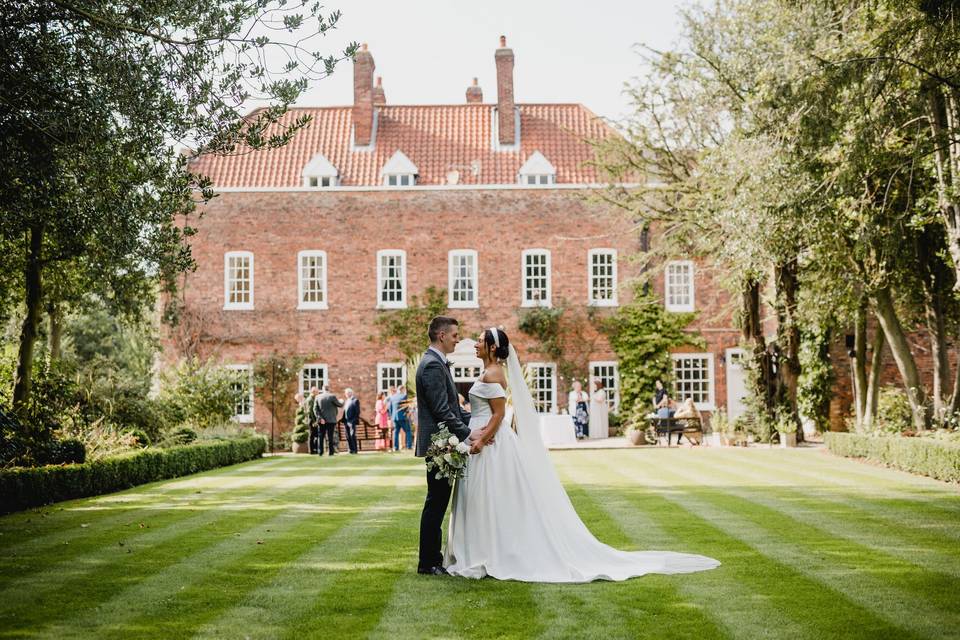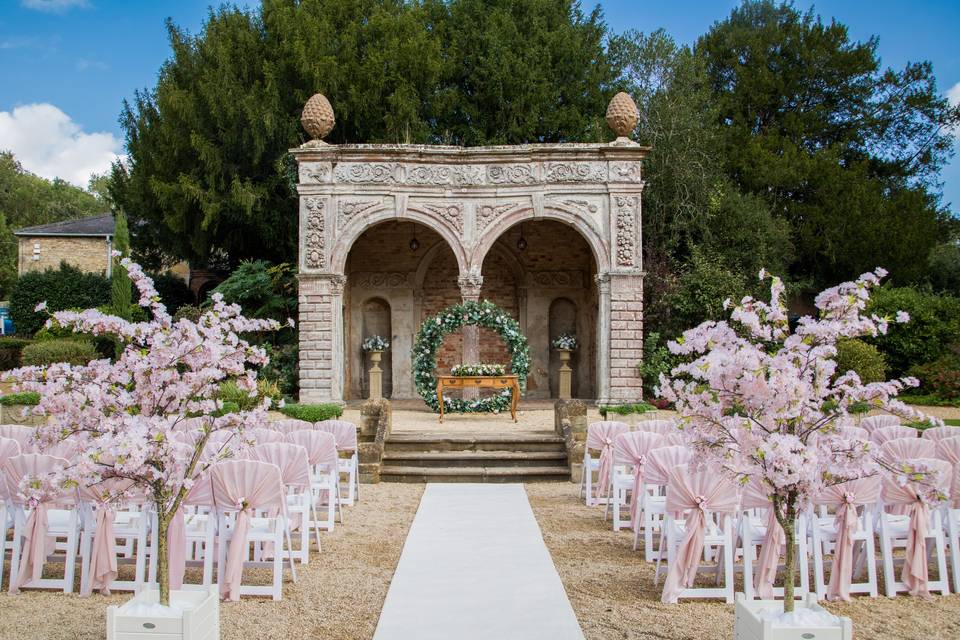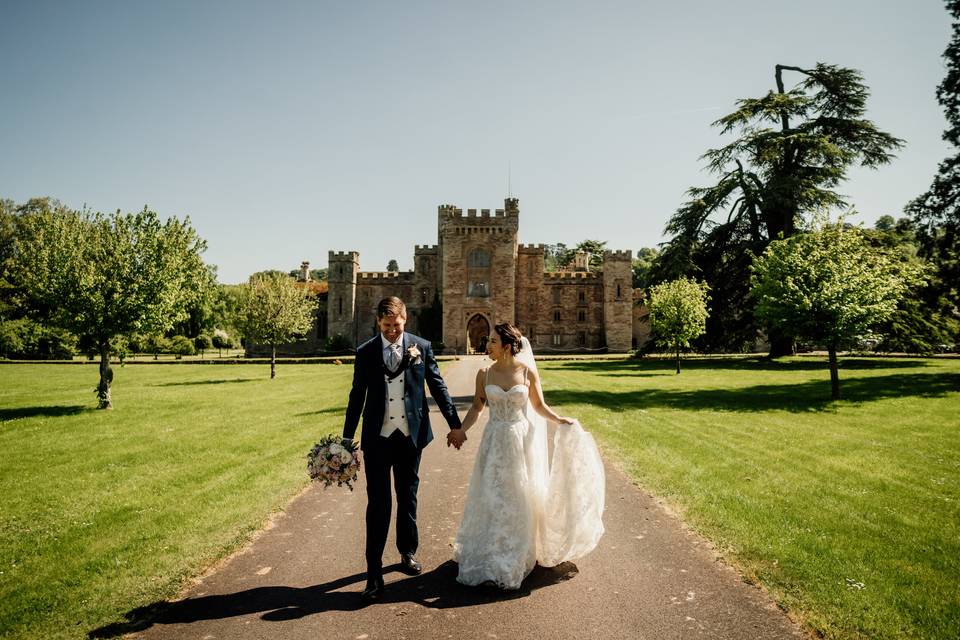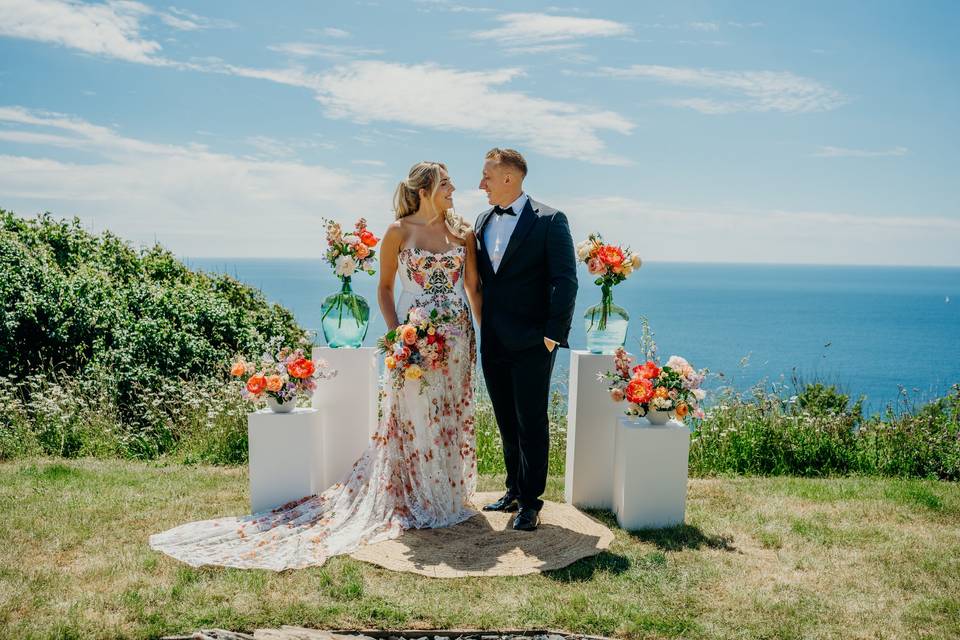Religious Wedding Ceremony Order of Service: Christian, Muslim, Jewish, Hindu & Sikh Weddings
We breakdown the order of a Christian, Muslim, Jewish, Hindu and Sikh wedding ceremony to help you write your order of service and plan the perfect ceremony for you.
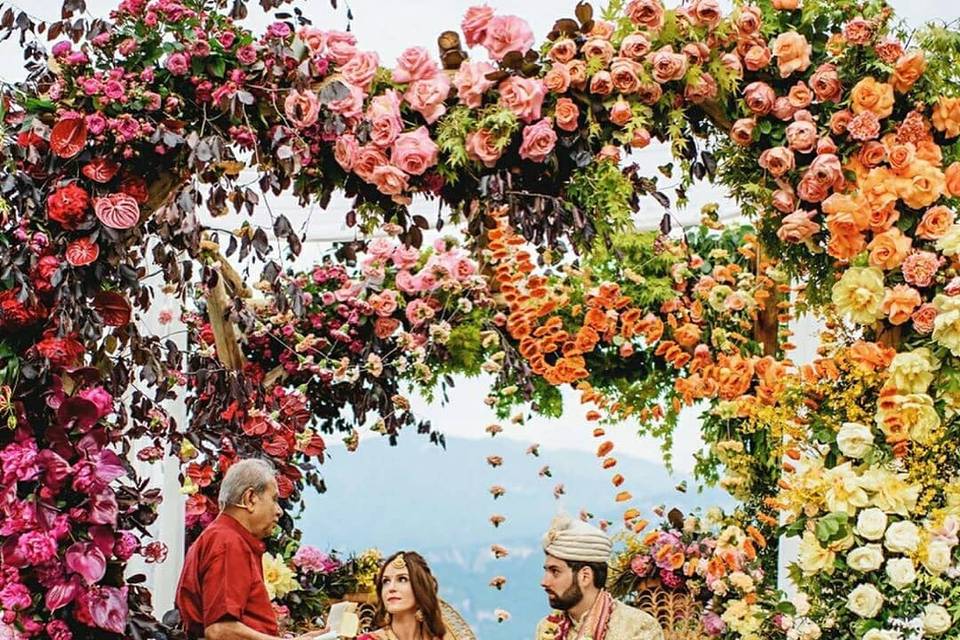
If you've attended a few weddings, you probably know the rough order of a traditional wedding ceremony: the walk down the aisle, the exchange of vows, the kiss, the couple's exit and so on.
But when you're actually getting married and have to decide the order of service for your wedding, you'll probably need a little help to know exactly what happens when during the ceremony. Add into that the diverse traditions and distinct elements of different cultures and religions and you'll probably be on the hunt for an article that breaks down the main structure of the ceremony for each religion. How handy that we've done just that!
Below, you'll find the basic wedding ceremony order for Christian, Muslim, Jewish, Hindu and Sikh weddings. Unlike civil ceremonies, there is often little flexibility in the order of the service and you follow a traditional structure with the addition of a few personal choices of music or readings.
- Christian Wedding Ceremony Order of Service
- Muslim Wedding Ceremony Order of Service
- Jewish Wedding Ceremony Order of Service
- Hindu Wedding Ceremony Order of Service
- Sikh Wedding Ceremony Order of Service
- Is My Religious Wedding Legally Recognised in the UK?
Christian Wedding Ceremony Order of Service
The biggest Christian denominations in the UK are Church of England and Catholic, and each have similar components to the marriage ceremony - entrance, sermon, exchange of vows, giving of rings, prayers and blessing - but with different practices.
Many denominations like Methodist and Baptist follow a similar order of service to the Church of England, however they differ in significant ways, such as their approach to same-sex marriage. While same-sex weddings or blessings are not currently allowed in the Church of England or Catholic Church, they are permitted in other denominations such as Church of Scotland, Quaker and the United Reformed Church, with the Methodist church allowing blessings.
A Catholic wedding ceremony can include mass but doesn't need to, and it will be something you discuss with your priest. There is not much chance to personalise or change the order of the Catholic ceremony and your priest will tell you what to expect.
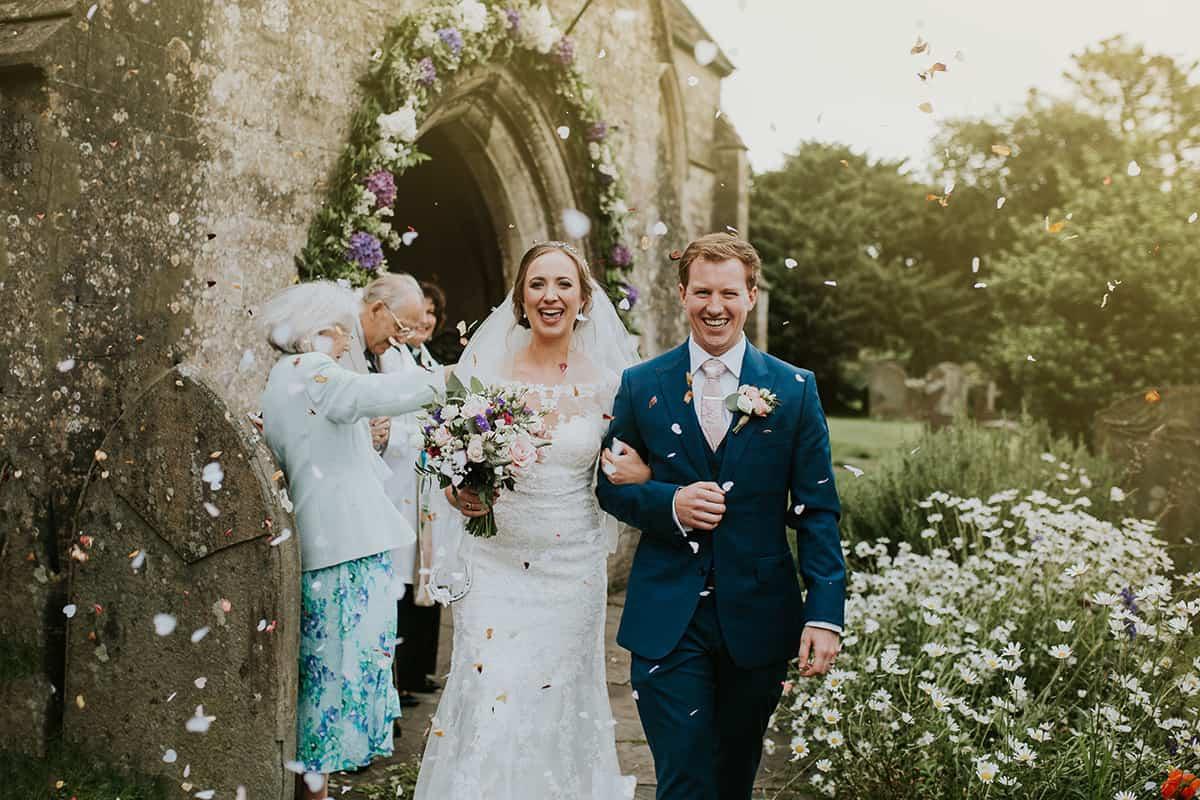
Church of England Wedding Ceremony Order of Service
Processional
The entrance of the bride (usually with her father) to music. The wedding party head down the aisle in pairs, with the flower girl and page boy at the front, and the bride comes down last. She is "given away" at the altar by her father.
Welcome
The vicar will say a few words to welcome everyone. This is usually followed by a hymn - you will want to include the lyrics in your order of service - and then an introduction by the vicar on the importance of marriage and what the coming ceremony represents.
Declaration and Vows
The vicar will explain the sanctity of the vows they are about to take and the couple will then exchange vows. Some couples include a bible reading here; this could also be when the vicar gives a short sermon. Otherwise, the service may continue straight on with the vows. You can choose to follow traditional phrasing of the vows or share personal vows you've written yourself - this may depend on the vicar.
Exchange of Rings
The vicar blesses the rings. The couple place the ring on each other's finger and the vicar proclaims you married.
The Kiss
The couple seal their new marriage with a kiss.
Signing of the Register
Signing of the register is done away from your guests, sometimes in a separate room, in front of two witnesses. The couple must sign the marriage register for the wedding to be legal. Typically there is music or a hymn sung during this time.
If you're having a blessing of a civil ceremony, you won't sign the register here as you already have done that.
Bible Reading
There will often be a Bible reading here and this is usually where the vicar gives a short talk.
Final Prayer and Blessing
The vicar will lead final prayers with everyone joining together to say the Lord's Prayer before the vicar's final blessing.
Hymn (Optional)
There may be a final hymn sung at this point, either before the couple exit or as they leave the church. Remember again to put the hymn lyrics in the order of service.
Exit of Couple
Normally set to music, the newlyweds walk out the church, followed by the wedding party and then their parents. Following this are the confetti throw and photographs.
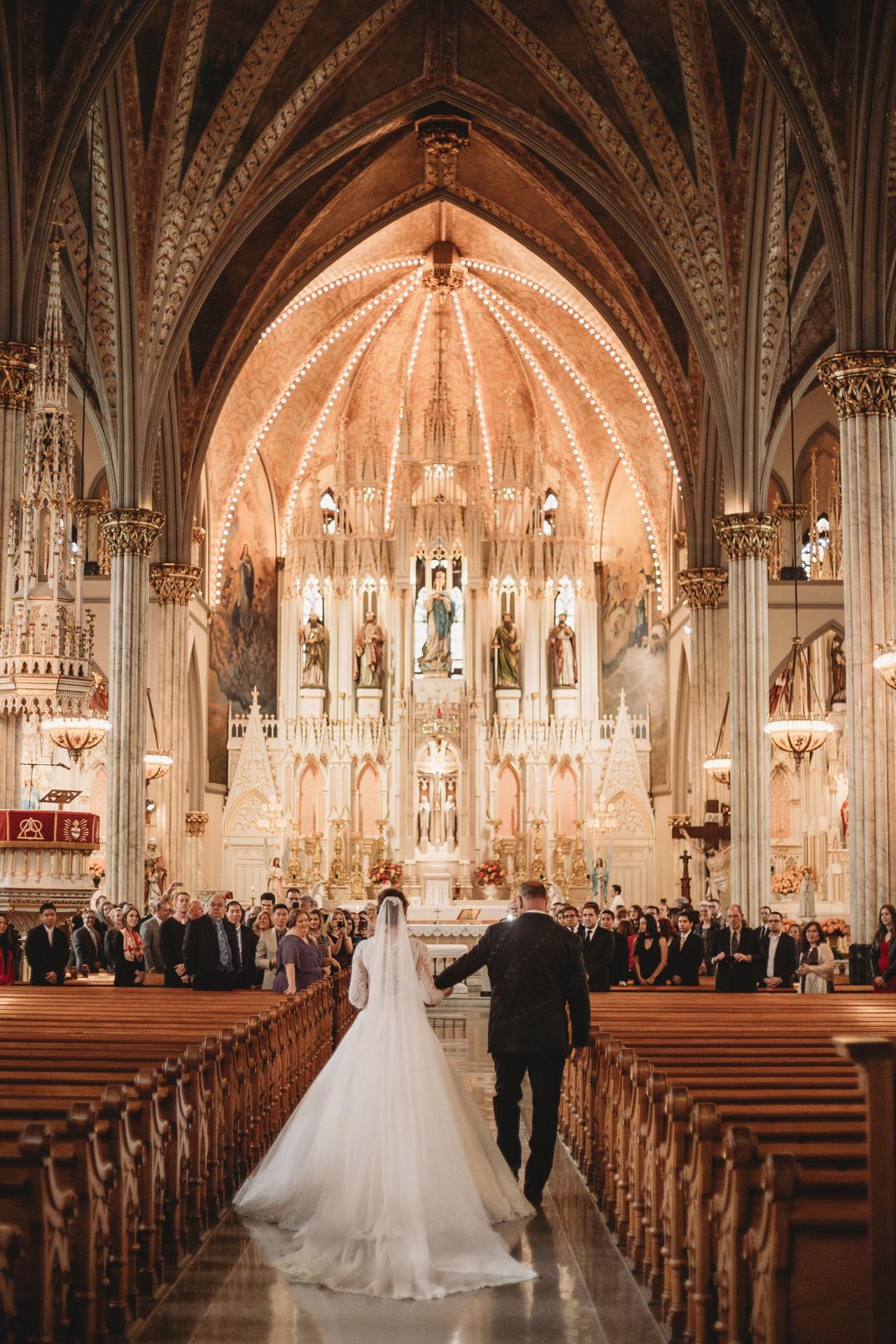
Catholic Wedding Ceremony Order of Service
Entrance Rite
The priest and ministers walk down the aisle, followed by the groom, wedding party and, lastly, the bride and her father. The priest greets the congregation and begins with rites and a prayer and often a hymn, like the Kyrie or Gloria, is sung.
Liturgy of the Word
This is one reading from the Old Testament and one from the New Testament with a psalm in between that the guests sing in response.
Gospel
The Gospel Acclamation is given, followed by a reading from one of the four gospels. The guests stand for this.
Homily
The priest offers a sermon, usually about marriage, taken from the scripture.
Exchange of Vows
There are several different options for Catholic marriage vows, however, they cannot be personalised. The couple will repeat their vows or respond with "I do" to the priest.
Giving of Rings
The wedding rings are blessed with prayer and holy water. The couple place a ring on each other's finger and recite a promise. This is likely when the kiss will happen. A song may be sung after where select guests offer gifts to the couple and seated guests give donations to the church.
The Eucharist
If happening, this is when the Holy Eucharist happens and the bread and wine are blessed.
The Lord's Prayer
The Lord's Prayer is recited by the guests and a sign of the peace is offered. It is followed by the nuptial blessing.
Holy Communion
If happening, this is when mass will take place, with those who are Catholic offered Holy Communion.
Recessional
A final prayer is said and the newlyweds walk back up the aisle. The couple may kiss again before they begin their walk.
Muslim Wedding Ceremony Order of Service
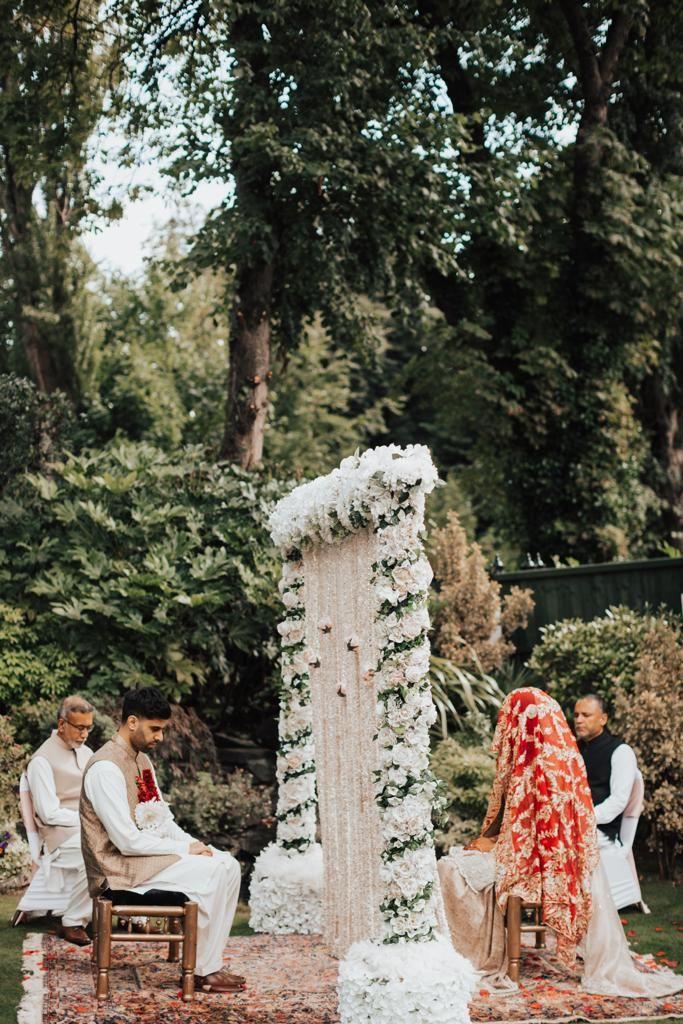
This is known as the Nikkah ceremony. Traditions vary greatly depending on cultures and sects, but usually the ceremony itself is short.
The Proposal
The groom proposes to the bride in front of two witnesses.
The Acceptance
The bride and groom repeat 'qabul' ('I accept') three times when asked by the Imam.
The Signing of the Contract
The couple and two witnesses sign the meher, which is the marriage contract.
The Savaqah
This is the last part of the Muslim ceremony. As the couple exits the ceremony, the bride is showered in coins in celebration.
Before this final part, there can be other elements such as a recitation of the Fatihah - the first chapter of the Quran - and durud (blessings). The couple may share a sweet fruit such as a date too. Depending on family and religious tradition, couples may choose to add other elements.
Hindu Wedding Ceremony Order of Service
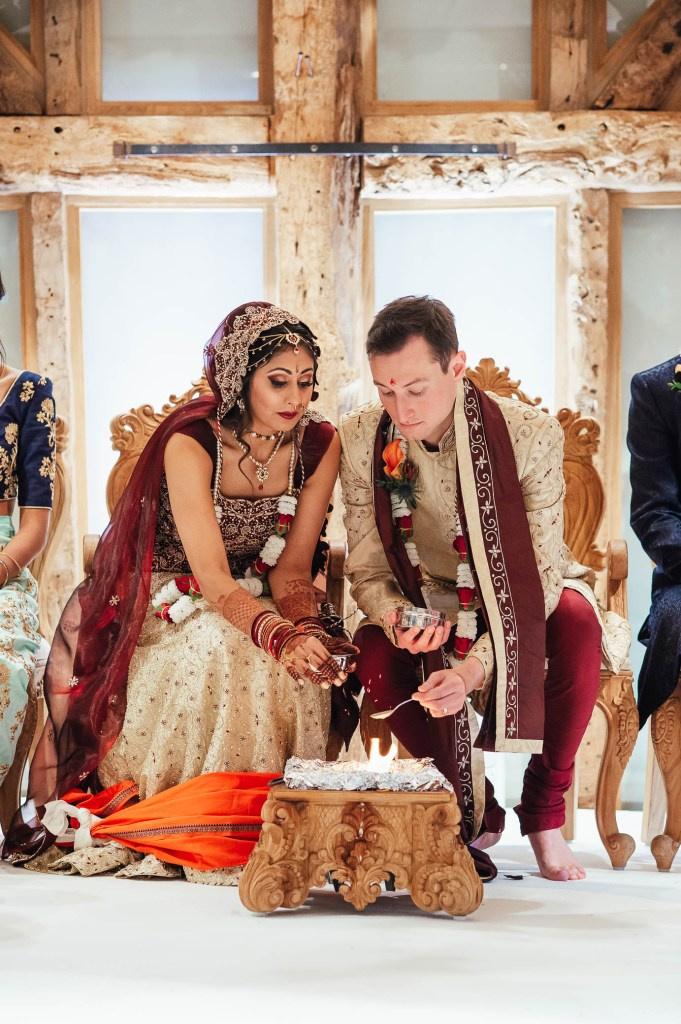
There are several Hindu pre- and post-ceremony traditions. This order of service template for the main service is a guide; there are significant regional and cultural variations.
The Groom's Arrival
The arrival of the couple is an important part of the ceremony. The groom arrives first to a traditional welcome that varies according to culture. The groom's procession is called the baraat, and will often take place on a white horse. He makes his way to the Mandap to take his seat before the wedding rituals begin.
A Prayer to Lord Ganesh
The priest will give a prayer to Lord Ganesh, the Hindu elephant God, to bestow good luck on the couple and their families and remove obstacles.
The Arrival of the Bride
This may happen before or after the prayer to Ganesha. She takes her place at the Mandap with her soon-to-be husband.
Garland Exchange
The couple exchange garlands of fresh flowers in the jai mala ceremony. It represents the acceptance of their forthcoming union.
Giving Away the Bride
This symbolic giving away of the bride can happen earlier in the ceremony, too. She is given away by her father in a tradition known as the kanyadaan.
The Tying of the Garments (Saptapadi)
The couple have their wedding scarves tied together and take four or seven circles around the ceremonial fire in the centre of the Mandap. They also take seven steps together. The bride offers puffed rice to the fire or the couple shower each other with rice.
Blessings
First Meal as Newlyweds
The couple share a sweet called a kansar, as a symbol of their union.
Sindoor & Mangala Sutra
The groom ties a traditional black and gold necklace around the bride's neck, then applies red power to her hair or as a dot on her forehead.
Vidaai
This is the farewell by the bride to her family, which involves her throwing a handful of rice over her shoulder.
Jewish Wedding Order of Service

There are a variety of Jewish pre- and post-ceremony traditions and this example order for the main service is just a guide. Your Rabbi will be able to give you a full breakdown of what is expected of you.
Entering the Chuppah
The wedding party enter the Chuppah, where the bride circles the groom three or seven times. Traditionally the groom's parents walk him down the aisle, then the bride and her parents follow and both sets of parents will stand under the Chuppah during the ceremony.
Betrothal Blessings
The rabbi gives the betrothal blessings and the couple drinks from a cup of wine.
Ring Ceremony
The couple exchange rings and make their vows.
The Ketubah
The ketubah - marriage contract, signed before the ceremony - is read out and given to the couple.
Speech
At this point the rabbi will often give a speech about marriage and the responsibilities of it.
The Seven Blessings
The rabbi recites the Sheva B'rachot, or Seven Blessings, then the couple drink from a cup of wine. They are often read in both Hebrew and English and begin with blessing the cup of wine.
Breaking of the Glass
The groom breaks a glass that is wrapped inside a cloth bag with his foot. This is meant to symbolise the destruction of the temple in Jerusalem and the Rabbi will usually read a verse from Psalm 137 about remembering Jerusalem before the glass is broken.
Mazel Tov!
The ceremony ends with the breaking of the glass, at which point you will hear all the guests cheer "Mazel tov!" Tradition dictates that couples spend eight minutes in seclusion (yichud) following the ceremony and often share their first meal together as a married couple.
Sikh Wedding Order of Service
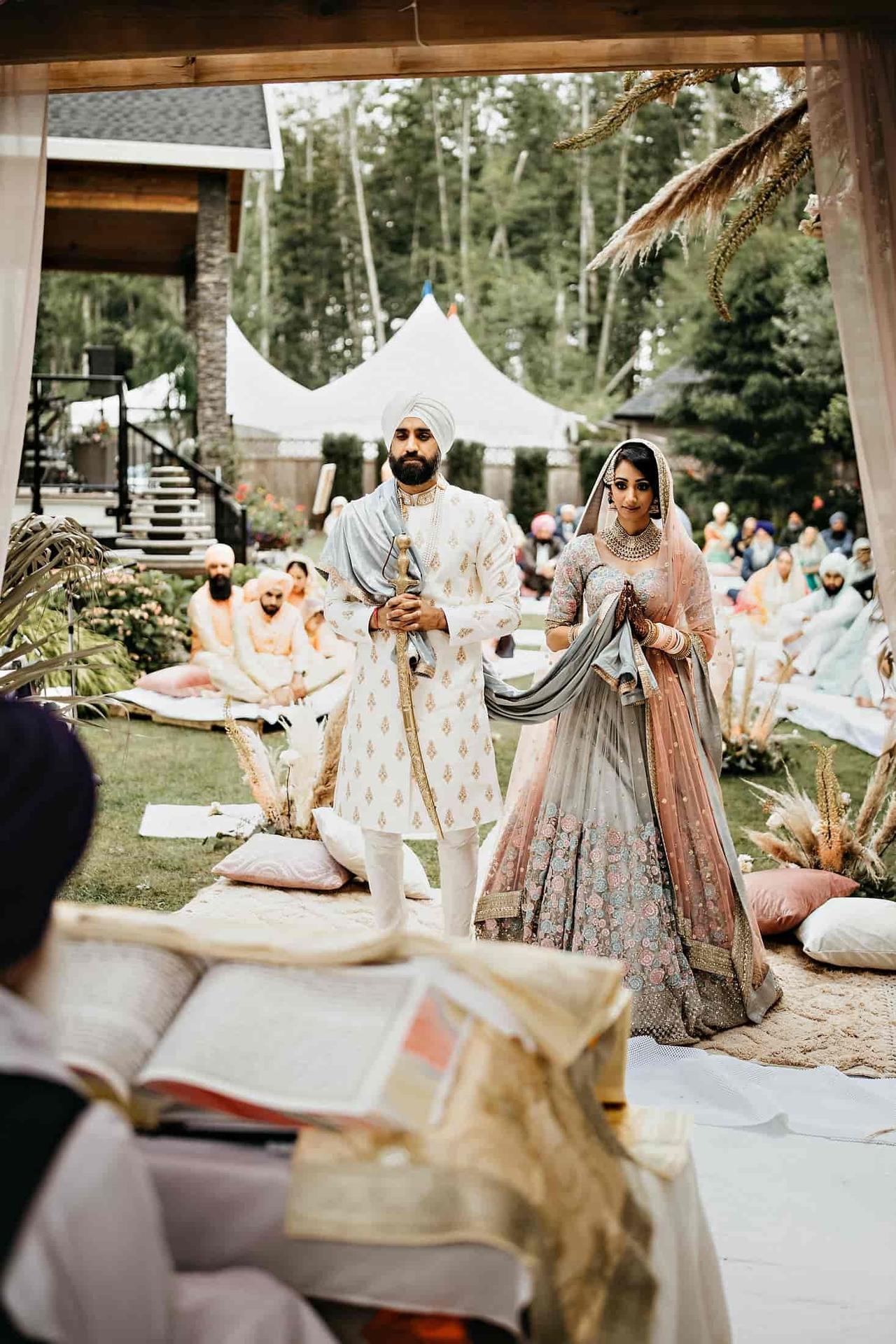
Again, there are lots of variations to Sikh wedding ceremonies and this is just a basic outline of what to expect for the order of the day.
The Baraat
The groom leaves his house with his family and friends to go to the Gurudwara where the bride's family and guests receive him. The groom must cut through a red ribbon held by the bride's side, but he isn't given the scissors until he places money in a glass filled with water.
The Milni Ceremony
Both families congregate in front of the Gurudwara for the formal introductions of the relations and the exchange of garlands and a gift. The priest starts the milni with a small prayer.
The Anand Karaj
This is the 'blissful union' of the couple, centred around the Sri Guru Granth Sahib (Holy Book). The relatives and guests enter the darbar (main hall) while the priest sings shabads (hymns). The groom enters first, then the bride, separately carrying a rumalla, a rectangular silk cloth for the book, and pay their respects and say prayers, known as Ardas.
The Giving Away of the Bride
The father of the bride comes down to the front and performs the palla rasam, where one end of the palla is given to the groom and the other end is tied of handed to his daughter.
The Laavan
The priest recites four laavs, which are marriage hymns. They are both teachings about marriage and the vows which seal the marriage union. The bride and groom then bow down and walk clockwise around the altar. She is often also led by her family members as well as her husband. The priest ends with a final hymn and prayer.
Giving of Shagun
The parents put garlands of flowers round the couple and give them shagun, which is money as a blessing.
Is My Religious Wedding Legally Recognised in the UK?
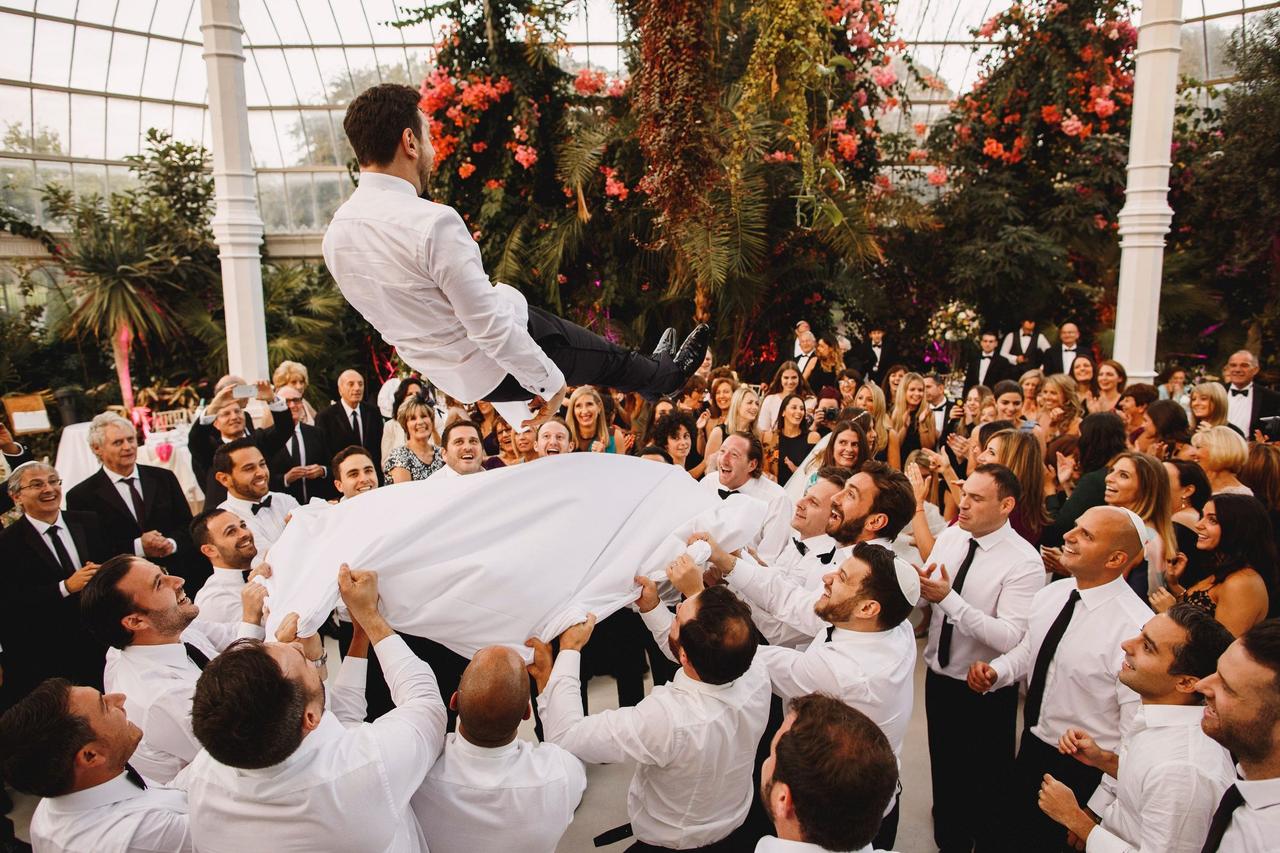
To be legally married under UK law has a number of requirements, such as giving notice before the wedding, the wedding taking place in an approved venue, that the wedding is carried out by an authorised person, witnessed and entered into the marriage register, and that certain legal declarations are made.
Religious marriages have varying legal requirements, but if they are not carried out then the marriage is not legally valid.
- Ordained Church of England and Catholic clergy are allowed to perform marriage rites and will register the marriage. Two witnesses must be present and the ceremony must follow the rules of those religions to be valid.
- In Jewish ceremonies, the Rabbi can legally officiate and will make sure the wedding follows Jewish religious rules and that Jewish witnesses are present. The Rabbi will also register the marriage. Jewish weddings do not need to take place inside buildings or in public.
- Muslim, Sikh and Hindu marriages must take place in a registered building. Religious leaders, such as an Imam, are not automatically authorised to perform legal weddings and must either be registered or have a registrar on hand to make the marriage legal. There will need to be two witnesses present and legal declarations must be made by both parties. Often Muslim, Sikh and Hindu couples will have a civil ceremony before or after the religious ceremony; this will be seen as a formality as the significant ceremony will be the religious one.
A marriage is only legal in the UK if you are issued with a marriage certificate so it's important to check beforehand if you need to have a civil ceremony in addition to your religious ceremony. These can be very quick and take less than 10 minutes at the register office. Here's what a civil ceremony will look like:
Welcome and Introductions
The registrar will give a brief welcome to the couple and guests.
Reading or Music (Optional)
Readings and music are all optional in a civil ceremony. You'll need to run all readings and music past the register office as they cannot have religious references.
The Marriage Ceremony
To make the marriage legal, there are legal statements, declarations and contracting words you must say. You can simply go with the official wording to keep it simple, or personalise the ceremony. You can also exchange rings afterwards, but that's optional. You can also add your own vows - as with readings, you'd need to check these with the registrar in advance.
Reading or Music
Another optional reading.
Signing of the Register
The couple will sign the register and then walk back up the aisle with music playing.

